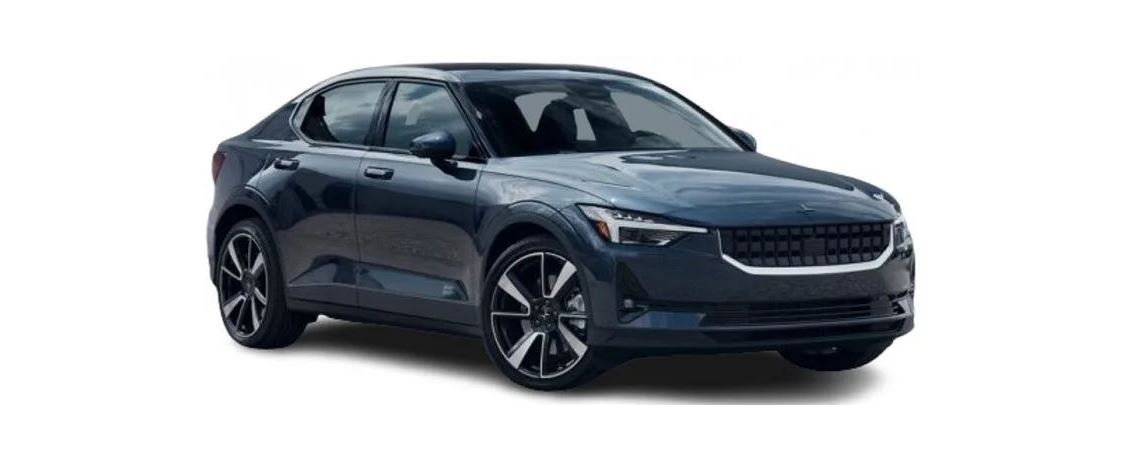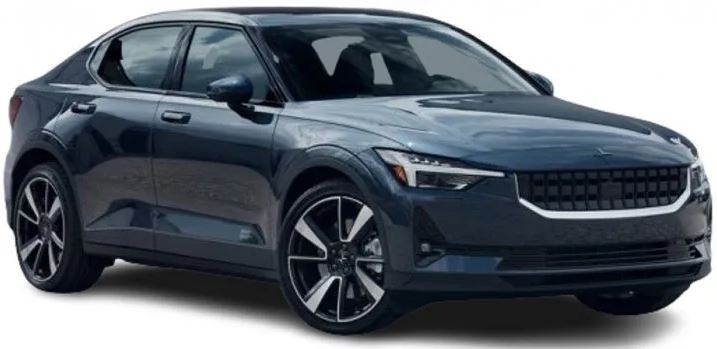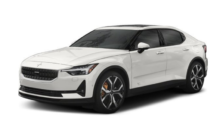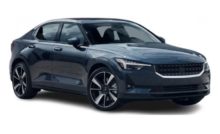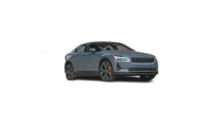- If the warning light for the airbags remains illuminated after the vehicle is started or if it lights up while you are driving, contact Polestar Customer Support as soon as possible.
- Never attempt to alter or repair any of the vehicle’s safety systems yourself. Incorrectly performed repairs to any system could impair function and lead to serious injury. Contact Polestar Customer Support.
If your vehicle has become water-damaged in any way (e.g., soaked floor mats/standing water on the floor of the vehicle), do not attempt to start the engine. This may cause airbag deployment, which could result in serious injury. Contact Polestar Customer Support.
Before attempting to tow the vehicle:
- Switch off the ignition for at least 10 minutes and disconnect the battery.
- Follow the instructions for manually overriding the shift lock system.
Deployed airbags
If any of the airbags have deployed:
- Do not attempt to drive the vehicle. Contact Polestar Customer Support.
- If necessary, seek medical attention.
Driver/passenger-side front airbags
Driver/passenger-side front airbags
In a frontal collision, the airbags help protect the driver’s and passenger’s head, neck, face, and chest and the driver’s knees and legs.
A collision of a sufficiently violent force will trigger the sensors and one or more airbags will inflate. The airbag helps cushion the initial impact of the collision for the passenger. The airbag deflates when compressed by the collision. A small amount of powder will also be released from the airbag. This may appear to be smoke and is normal. The entire process, from inflation to deflation of the airbag, occurs within tenths of a second.
The sensors react differently depending on the circumstances of the accident and whether or not the seat belt is used. This applies to all belt positions.
In some accident situations, only one (or none) of the airbags will be deployed. The sensors monitor the impact of the collision and react accordingly to deploy one, several, or no airbags.
The seat belt and the airbag work together. If the seat belt is not used or is used incorrectly, the airbag may not provide the intended protection in a collision.
To help prevent injury in the event the airbag is deployed, passengers should sit as upright as possible, with their feet on the floor and their backs against the seat backrest.
Contact Polestar Customer Support for repairs. Incorrectly performed repairs to the airbag system could impair function and lead to serious injury.
The front airbag system
The front airbag system includes gas generators surrounded by airbags and deceleration sensors that activate the gas generators, causing the airbags to be inflated with nitrogen gas.
As the movement of the seats’ occupants compresses the airbags, some of the gas is expelled at a controlled rate to provide better cushioning. The belt tensioners minimize slack in the seat belts and are activated for occupants wearing their seat belts. The entire process, from inflation to deflation of the airbag, occurs within tenths of a second.
The location of the front airbags is indicated by SRS AIRBAG embossed on the steering wheel pad and above the glove compartment, and by decals on both sun visors and on the front and far-right side of the dash.
The driver’s side front airbag is folded and located in the steering wheel hub.
The knee airbag is folded on the underside of the dashboard on the driver’s side. The text AIRBAG is embossed on the panel.
The passenger’s side front airbag is folded behind a panel located above the glove compartment.
- The airbags in the vehicle are designed to be a SUPPLEMENT not a replacement for the three-point seat belts. For maximum protection, wear seat belts at all times. Be aware that no system can prevent all possible injuries that may occur in an accident.
- Never drive with your hands on the steering wheel pad/airbag housing.
- The front airbags are designed to help prevent serious injury. Deployment occurs very quickly and with considerable force. During normal deployment and depending on variables such as seating position, one may experience abrasions, bruises, swellings, or other injuries as a result of the deployment of one or both of the airbags.
- When installing any additional equipment, make sure that the front airbag system is not damaged. Any interference in the system could cause malfunction.
Front airbag deployment
- The front airbags are designed to deploy during certain frontal or front-angular collisions, impacts, or decelerations, depending on the crash severity, angle, speed, and object impacted. The airbags may also deploy in certain non-frontal collisions where rapid deceleration occurs.
- The airbag system’s sensors, which trigger the front airbags, are designed to determine if the collision is powerful enough to activate the belt tensioners and/or the airbags.
However, not all frontal collisions activate the front airbags.
- If the collision involves a nonrigid object (e.g., a snow drift or bush), or a rigid, fixed object at a low speed, the front airbags will not necessarily deploy.
- Front airbags do not normally deploy in a side-impact collision, in a collision from the rear, or in a rollover situation.
- The amount of damage to the bodywork does not reliably indicate if the airbags should have been deployed or not.
- The front airbags and seat belt tensioners may be activated in a collision. The airbags are only deployed one time during an accident. Some noise occurs and a small amount of powder is released. The release of the powder may appear as smoke-like matter. This is a normal characteristic and does not indicate a fire.
- Polestar’s front airbags use special sensors that are integrated with the front seat belt buckles. The point at which the airbag deploys is determined by whether or not the seat belt is being used, as well as the severity of the collision.
- Collisions can occur where only one of the airbags deploys. If the impact is less severe, but severe enough to present a clear injury risk, the airbags are triggered at partial capacity. If the impact is more severe, the airbags are triggered at full capacity.
- Do not use child safety seats or child booster cushions/backrests in the front passenger’s seat. Polestar follows NHTSA’s recommendations and recommends that ALL children up to and including 12 years of age sit in the rear seat. This is very strongly recommended for children sitting in rear-facing child seats. Also, see Occupant Classification System information.
- Never drive with the airbags deployed. The fact that they hang out can impair the steering of your vehicle. Other safety systems can also be damaged.
- The smoke and dust formed when the airbags are deployed can cause skin and eye irritation in the event of prolonged exposure.
If you have questions about any component in the supplemental restraint system, contact Polestar Customer Support or:
In the USA:
Polestar Automotive USA Inc.
Customer Support
777 MacArthur Blvd
Mahwah, New Jersey 07430
1-800-806-2504
In Canada:
Polestar Automotive Canada Inc.
9130 Leslie Street, Suite 101
Richmond Hill, ON L4B 0B9
1-800-806-2507
Airbag decals
Airbag decal on the outside of both sun visors.
Passenger’s side airbag decal.
- Children must never be allowed in the front passenger’s seat.
- Occupants in the front passenger’s seat must never sit on the edge of the seat, sit leaning toward the instrument panel, or otherwise sit out of position.
- The occupant’s back must be as upright as comfort allows and be against the seat back with the seat belt properly fastened.
- Feet must be on the floor, e.g., not on the dash, seat, or out of the window.
- No objects or additional equipment, e.g. dashboard covers, may be placed on, attached to, or installed near the airbag cover (the area above the glove compartment) or the area affected by airbag deployment.
- There should be no loose articles, such as coffee cups on the floor, seat, or dashboard area.
- Never try to open the airbag cover on the steering wheel or the passenger’s side dashboard. This should only be done by a trained and qualified service technician.
- Failure to follow these instructions can result in injury to the vehicle’s occupants.
Far-side airbags
The far-side airbags are located in the front seats’ inner backrest frames and help protect the driver and front-seat passenger. AIRBAG is embossed on the seat.
A collision of a sufficiently violent force will trigger the sensors and one or more far-side airbags will inflate. The airbag inflates between the seat occupant and the tunnel console to help cushion the initial impact of the collision. The far-side airbag normally only inflates for the seat on the opposite side of the impact side.
Contact Polestar Customer Support for repairs. Incorrectly performed repairs to the side airbag system could impair function and lead to serious injury.
Do not place any objects in the area between the inner edges of the seats and the tunnel console, as this could impair the function of the side airbags.
Polestar recommends only using Polestar-approved seat covers. Other seat covers could prevent the side airbags from functioning properly.
The side airbag is a supplement to the seat belt. Always wear your seat belt.
Inflatable curtain
The inflatable curtains are installed along both sides of the inside of the roof and help protect occupants in the vehicle’s outer seats. IC AIRBAG is embossed on the panels.
A collision of a sufficiently violent force will trigger the sensors and the inflatable curtain will inflate.
Contact Polestar Customer Support for repairs. Incorrectly performed repairs to the inflatable curtain system could impair function and lead to serious injury.
Never hang or attach heavy objects to the handle in the ceiling. The hooks are only intended for lightweight garments (not for hard objects such as umbrellas).
Never screw or mount anything to the vehicle’s headlining, door pillars, or side panels. This could impair the intended protective properties. Polestar recommends only using original Polestar parts that are approved for placement in these areas.
If objects are loaded higher than the upper edge of the side windows, leave a 10 cm (4 in.) space between the objects and the window. Objects placed closer to this could impede the function of the inflatable curtain concealed inside the headlining.
The inflatable curtain is a supplement to the seat belt. Always wear your seat belt.
Near-side airbags
The near-side airbags are located in the front seats’ outer backrest frames and help protect the driver and front-seat passenger.
A collision of a sufficiently violent force will trigger the sensors and one or more near-side airbags will inflate. The side airbags inflate between the seat occupant and the door panel to help cushion the initial impact of the collision. The airbag deflates when compressed by the collision. The near-side airbag normally only inflates for the seat on the opposite side of the impact side.
Contact Polestar Customer Support for repairs. Incorrectly performed repairs to the side airbag system could impair function and lead to serious injury.
Do not place any objects in the area between the outer edges of the seats and the door panels, as this could impair the function of the side airbags.
Polestar recommends only using Polestar-approved seat covers. Other seat covers could prevent the side airbags from functioning properly.
The side airbag is a supplement to the seat belt. Always wear your seat belt.
Occupant Classification System
OCS indicator light.
The front airbag on the passenger side is either activated or deactivated depending on the classification of the passenger in the front passenger seat.
Polestar follows NHTSA’s recommendations and recommends that ALL children up to age 12 sit in the rear seat and are secured appropriately for their height and height. This is very strongly recommended for children sitting in rear-facing child seats.
| Classification of passengers in the front passenger seat | OCS indicator light status | Passenger’s side front airbag status |
|---|---|---|
| The passenger is classified as an adult. | OCS indicator light is not lit. | Activated |
| The passenger is classified as a small child in a forward-facing child seat. | The OCS indicator light is lit or not lit depending on several parameters that determine the most suitable status. | Enabled or disabled depending on several parameters that determine the most suitable status. |
| The passenger is classified as a small child in a rear-facing child seat. | OCS indicator light is lit. | Deactivated |
| The passenger seat is empty. | OCS indicator light is lit. | Deactivated |
Occupant Classification System function
OCS works in combination with sensors in the front passenger seat. The sensors are designed to detect the presence of, and classify a properly seated occupant and determine if the passenger’s side front airbag should be enabled (may inflate) or disabled (will not inflate).
The OCS uses an indicator lamp with the text PASSENGER AIRBAG OFF, which will illuminate and stay on to remind you that the passenger’s side front airbag is disabled. The indicator light with the text PASSENGER
AIRBAG OFF is located in the ceiling console, near the bracket for the rearview mirror.
Always make sure that the indicator light status shows the correct classification, both before and while driving, when the front passenger seat is occupied.
When the ignition is switched on, the OCS indicator light will illuminate for several seconds while the system performs a self-diagnostic test. The indicator light will then go out or remain illuminated, depending on the classification of the occupant of the front passenger seat.
If a malfunction is detected in the system, the OCS indicator light will remain illuminated and the SRS warning symbol will be shown in the instrument panel along with a text message.
If a fault in the system is detected and indicated as described, be aware that the passenger’s side front airbag will not deploy in the event of a collision. In this case, have the airbag system and the Occupant Classification System checked by a workshop as soon as possible.
Classification of adult
To help ensure accurate classification when a person of adult size is sitting in the front passenger seat, the passenger must:
- be wearing their seat belt
- be sitting normally in the seat, in the center of the seat cushion
- be sitting upright in the seat with their shoulders against the backrest
- have their legs comfortably extended with their feet on the floor?
- Correct seating position.
- Example of incorrect seating position – the passenger must not have slid forward on the seat cushion.
- Example of incorrect seating position – the passenger must be seated with their feet on the floor.
Example of incorrect seating position – the passenger must not fold the backrest to a lying position.
Remember the following when an adult is sitting in the front passenger seat:
- The passenger must never get up from the seat cushion using the armrest in the door or center console, by pushing their feet against the floor, or by pushing against the backrest.
- The passenger must never sit on the side of the seat cushion, slide forward on the seat cushion or fold the backrest to a lying position.
- The passenger must never sit on the seat wearing wet or thick clothing, e.g. ski wear or padded garments.
- Never place any objects between the passenger and the seat cushion, such as pillows, heating blankets or ordinary blankets, seat liners, or mats.
- Never place a radio transmitter (e.g. hunting radio or walkie-talkie) or device that is being charged (e.g. cellular phone, tablet, or computer) on or under the seat cushion. Never let anyone sitting on the passenger seat use a radio transmitter or device that is being charged.
Not following the above recommendations could adversely affect the functioning of the Occupant Classification System, which could lead to serious personal injury or even death.
If a person of adult size is sitting in the front passenger’s seat and the OCS indicator light is on, it is possible that the person isn’t sitting properly in the seat.
If this happens, turn off the vehicle and ask the person to follow the above instructions for accurate classification. Restart the vehicle and have the person remain in this position for about two minutes. This will allow the system to detect that person and enable the passenger’s frontal airbag.
If the OCS indicator light remains on even after this, the person should be advised to ride in the rear seat.
This may indicate restrictions in the OCS classification ability, such as that the person is too light to be classified as an adult. It does not necessarily indicate an OCS error.
Classification of child
Polestar follows NHTSA’s recommendations and recommends that ALL children up to and including 12 years of age sit in the rear seat. This is very strongly recommended for children sitting in rear-facing child seats.
If a child in a child seat is placed on the front passenger seat, the child seat must be installed according to the manufacturer’s instructions to help ensure accurate classification.
Remember the following if a child in a child seat sits in the front passenger seat:
- Never place any items or extras on the passenger seat, between the child seat and the seat cushion, or near the seat cushion.
- Never place a radio transmitter (e.g. hunting radio or walkie-talkie) or device that is being charged (e.g. cellular phone, tablet, or computer) on the seat cushion. Never let anyone sitting on the passenger seat use a radio transmitter or device that is being charged.
- Never place wet clothing or fluids on the passenger seat.
- Always correctly position the child seat so that the entire lower section of the child seat rests against the seat cushion.
- Always place a front-facing child seat as far back as possible against the backrest.
Not following the above recommendations could adversely affect the functioning of the Occupant Classification System, which could lead to serious personal injury or even death.
Modifications
If you are considering modifying your vehicle in any way to accommodate a disability, for example by altering or adapting the driver’s or front passenger’s seat(s) and/or airbag systems, please contact Polestar Customer Support or:
In the USA:
Polestar Automotive USA Inc.
Customer Support
777 MacArthur Blvd
Mahwah, New Jersey 074730
1-800-806-2504
In Canada:
Polestar Automotive Canada Inc.
9130 Leslie Street, Suite 101
Richmond Hill, ON L4B 0B9
1-800-806-2507
Never try to open, remove or repair any components in the OCS system. Contact Polestar Customer Support. Incorrectly performed repairs to the OSC system could impair function and lead to serious injury.
The front passenger’s seat should not be modified in any way. This could affect the function of the OSC system.

